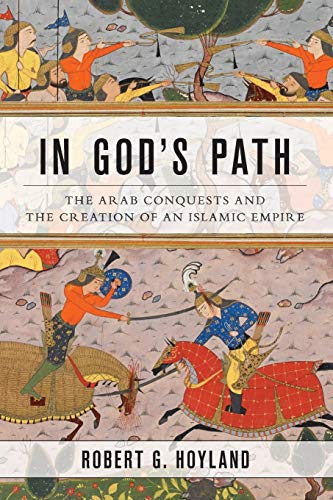|
In God’s Path: The Arab Conquests and the Creation of an Islamic Empire
By Robert G. Hoyland Published in 2014 Thibault’s Score: 3/5 The Arabs burst out of Arabia with incredible speed, rapidly conquering the entire known world. Within two hundred years, Islam had spread from Morocco to Malaysia. The speed of the Islamic conquests often baffles readers. However, the author points out that Christianity spread at a similar pace. He opens the book by telling a legend about some Christian saints who were fleeing the persecution of a pagan emperor. They hide in a cave and go to sleep. When they wake up, there are churches everywhere and the whole world has become Christian. To help them escape persecution, God had put them to sleep for 200 years. Another key element is that Islam was mostly a religion that only applied to elites. Conversion was discouraged (at first). As a result, most regions remained Zoroastrian, Christian, Jewish, or pagan for centuries. For example, in Egypt, the bulk of the population remained Christian until after the Crusades. In Persia, Muslims came to dominate the cities, but the mountainous and rural regions would remain Zoroastrian for four hundred years after the conquest. There is a particularly fascinating aspect of this book for anarchist-adjacent readers like me: the conquering armies were stateless and leaderless. The Caliphs were mostly religious figures, and had little practical authority or say about what happened on the field. Instead, the conquests were spearheaded by a decentralized network of warlords. If you want to learn about how anarchist-adjacent armies can conquer vast swaths of land, then this might be an interesting book for you. The decentralized nature of warfare resulted in a wide variety of outcomes. Some warlords were extremely merciful, while others were cruel. This can be seen during the siege of Damascus. Damascus, in modern day Syria, was a Byzantine fortress. It was attacked by two separate Muslim war parties that teamed up. One party stormed the citadel, and began a slaughter. In the early minutes of the slaughter, the Byzantine general (a man called Thomas) surrendered to the other Muslim party. This party granted the soldiers and civilians safe passage, and moved to restrain their peers in the slaughter. This angered the other Muslim commander who had to cancel his sack of the city. The truce, however, only lasted three days. So, the angered commander stalked the escaping Byzantine soldiers and civilians, waiting for the three days to end. At the dawn of the fourth day, he intercepted them before they arrived in Antioch, slaughtering and enslaving them. There was a great deal of discontent in the Sassanid Persian and Byzantine Empires. Both suffered from significant internal dissent and hatred of the central authorities. As a result, there were many regions inhabited by heretics who (without converting to Islam) willingly rose up in arms with the Muslims, aiding them in their conquests. Over time, especially when Muawia took over after the death of Ali, the Caliphs attempted to consolidate power and form states. They went from a role similar to those of 21st century popes into those of a king. These changes were resisted by many, notably the Kharijites and Shia. Many opposition groups would oppose the transformation of Islam, and maintain semi-stateless societies for centuries. Finally, ethnic tensions would cause the first Islamic states to crumble. Many Muslims wanted to place an emphasis on the racial superiority of Arabs. Others said that anyone who converted to Islam were Arabs. A third faction focused on Islam itself, saying that race was irrelevant, and pointed out that many of the early Muslims in Mohammed’s party had been black slaves. These ethnic tensions boiled down into race-wars. Ultimately, the pro-diversity factions won, and the pro-Arab factions lost in repeated crushing defeats. A more tolerant Sunni state - the Abbasid Caliphate - would emerge. This Caliphate would welcome the innovations of all peoples and religions, ushering in the golden age of Islam. This book is pretty well written. It avoids a lot of the hair-splitting which academics love to engage in to a large extent. However, it might be difficult to follow along if you are completely new to Islamic history. If you have a very rough idea of who major figures like Ali, Muawia, or Abu Muslim are - and have a rough idea of what the Rashidun, Umayyad, and Abbasid Caliphates are, then you will enjoy this book. Otherwise, you may need to supplement it with Wikipedia, YouTube videos, etc…
0 Comments
Leave a Reply. |
Thibault SerletMost of my articles are book reviews, but I also write about many other topics. Archives
December 2023
Categories |

 RSS Feed
RSS Feed